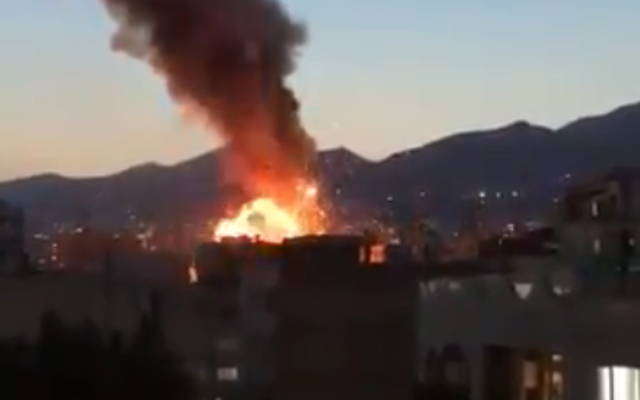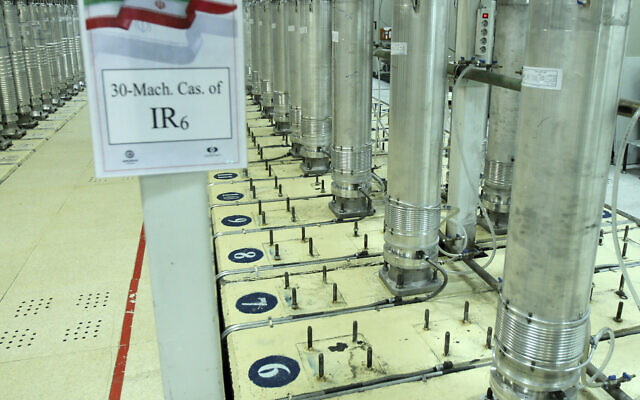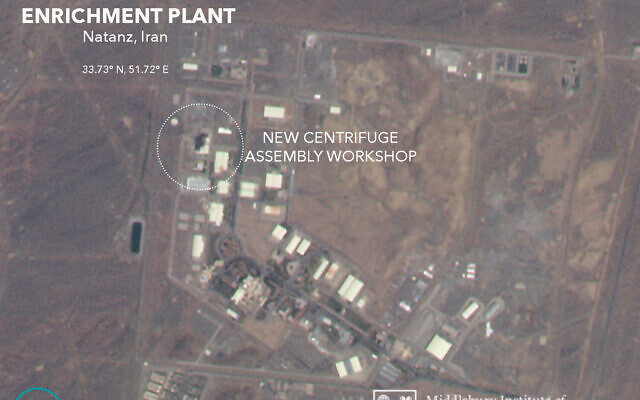Blast at centrifuge assembly facility may have set back development by 2 years, experts tell the NY Times, with series of strikes causing ‘extreme internal and external pressure’
By TOI STAFF 10 July 2020, 10:02 pm

The explosion at a health clinic in Tehran, Iran, on June 30, 2020. (Screen capture: Twitter)
An alleged Israeli attack on an advanced centrifuge development and assembly plant at Iran’s Natanz uranium enrichment facility exhibited the complexity of the Stuxnet virus that sabotaged Iranian enrichment centrifuges a decade ago, experts and analysts said in a new report Friday.
Officials with knowledge of the blast at Natanz last week told The New York Times that it was most likely the result of a bomb planted at the facility, potentially at a strategic gas line, but that it was not out of the question that a cyberattack was used to cause a malfunction that led to the explosion.
New satellite photographs from Natanz “show far more extensive damage than was clear last week,” the Times reported.
The Stuxnet virus was uncovered in 2010 and was widely reported to have been developed together by US and Israeli intelligence agencies. It penetrated Iran’s rogue nuclear program, taking control and sabotaging parts of its enrichment processes by speeding up its centrifuges. Up to 1,000 centrifuges out of 5,000 were eventually damaged by the virus, according to reports, setting back the nuclear program.

Centrifuge machines in the Natanz uranium enrichment facility in central Iran, November 5, 2019. (Atomic Energy Organization of Iran via AP, File)
The July 2 Natanz explosion was one of a series of mysterious blasts at Iranian strategic sites in recent weeks — the latest of which occurred Friday morning — which have once again been largely attributed to either Washington, Jerusalem, or both.
Friday’s blast “appeared to come from the direction of a missile base,” The Times noted. “If it proves to have been another attack, it will further shake the Iranians by demonstrating, yet again, that even their best-guarded nuclear and missile facilities have been infiltrated.”
Intelligence officials who assessed the damage to the Netanz centrifuge facility told The Times they believed it may have set the Iranians back by as much as two years.
And others asserted that the latest alleged attacks indicated an emergent strategy by Israel and the US — also including Washington’s assassination of top general Qassem Soleimani earlier this year — to carry out covert strikes that will hamper Iran’s regional and nuclear objectives while stopping short of leading to all-out conflict. “Some officials said that a joint American-Israeli strategy was evolving — some might argue regressing — to a series of short-of-war clandestine strikes, aimed at taking out the most prominent generals of the Islamic Revolutionary Guards Corps and setting back Iran’s nuclear facilities,” The Times reported.
Karim Sadjadpour, a senior fellow at Washington-based think tank the Carnegie Endowment for International Peace, told the newspaper that the latest attacks had led to “extreme internal and external pressure” on Iran as it grapples with an economic crisis and punishing US sanctions.
A spokesman for Iran’s foreign ministry said Friday that the cause of the Natanz explosion was not yet known, but warned that the country would retaliate severely if it emerges that a foreign entity was involved, according to the semi-official Fars news agency.
However, he also sought to downplay Israeli involvement, claiming that such reports were only intended to aggrandize Israel and asserting that Jerusalem claims responsibility for incidents “in every corner of the world.”
Iran on Tuesday had called for action against Israel following the damage to the Natanz facility. “This method Israel is using is dangerous, and it could spread to anywhere in the world,” government spokesman Ali Rabiei said during a press conference.

A satellite image from Planet Labs Inc. that has been annotated by experts at the James Martin Center for Nonproliferation Studies at Middlebury Institute of International Studies shows a damaged building after a fire and explosion at Iran’s Natanz nuclear site, on July 3, 2020. (Planet Labs Inc., James Martin Center for Nonproliferation Studies at Middlebury Institute of International Studies via AP)
He added: “The international community must respond and set limits to these dangerous actions by the Zionist regime.”
His comments came as Iran appeared to publicly acknowledge on Tuesday that last week’s fire at Natanz was not an accident.
The latest mysterious blast in Iran came early Friday, as Iranian media reported an explosion in western Tehran, prompting electricity to be cut in surrounding suburbs.
Iran’s official IRIB news agency reported the blast, citing online reports by residents. A member of the Iranian parliament, Hossein Haghverdi, denied that any explosion occurred, saying the power outage was due to a problem at a nearby power station, according to The New York Times.
The mayor of a nearby town, however, confirmed that there was an explosion, but said it came from a factory that filled gas cylinders.
An analyst told The New York Times there were underground military installations in the area.
On Tuesday, an explosion reportedly damaged a factory south of Tehran. According to Iranian media reports, two people were killed and three were injured in the blast at the Sepahan Bresh factory in the Kahrizak district.
The area’s governor said human error was to blame for the incident.
An explosion also reportedly damaged a power plant in the Iranian city of Ahvaz last Saturday. A few hours later, the Islamic Republic News Agency said a chlorine gas leak at a petrochemical center in southeast Iran sickened 70 workers.
A week before the Natanz blast, an explosion was felt in Tehran, apparently caused by an explosion at the Parchin military complex, which defense analysts believe holds an underground tunnel system and missile production facilities.
Israel has also been reported to have been behind a cyberattack in May on an Iranian port facility, causing widespread chaos, apparently in retaliation for an attempt by Tehran to target Israel’s water infrastructure.
Channel 13 news reported that the April assault on Israeli water command and control systems had greatly angered Israeli leaders, who saw it as a significant escalation by Iran and a crossing of a red line because it targeted civil infrastructure.



Another new explosion near Tehran on Saturday might be a missile storage facility. Iran regime trying to spin it as a gas explosion in an apartment building.
“840 new cases of coronavirus in Israel – Inside Israel
The Health Ministry reported on Friday evening that 840 Israelis had tested positive for coronavirus since midnight.
The number of active cases of coronavirus currently stands at 16,739. Among those, 130 in serious condition and 42 are on ventilators.
Two deaths were recorded since midnight, bringing the country’s death toll from the virus to 351.
Earlier on Friday, the government imposed lockdowns on nearly a dozen neighborhoods in five different cities across the country.” (from Frday’s Arutz Sheva). I wish Israel were handling its V-2 problem as well as it is managing the Iranian threat.